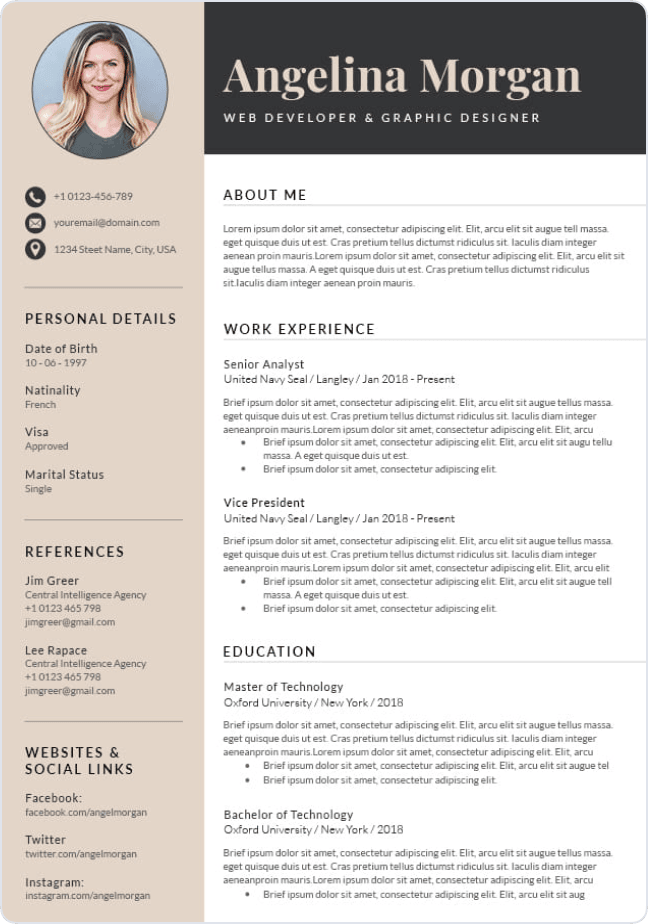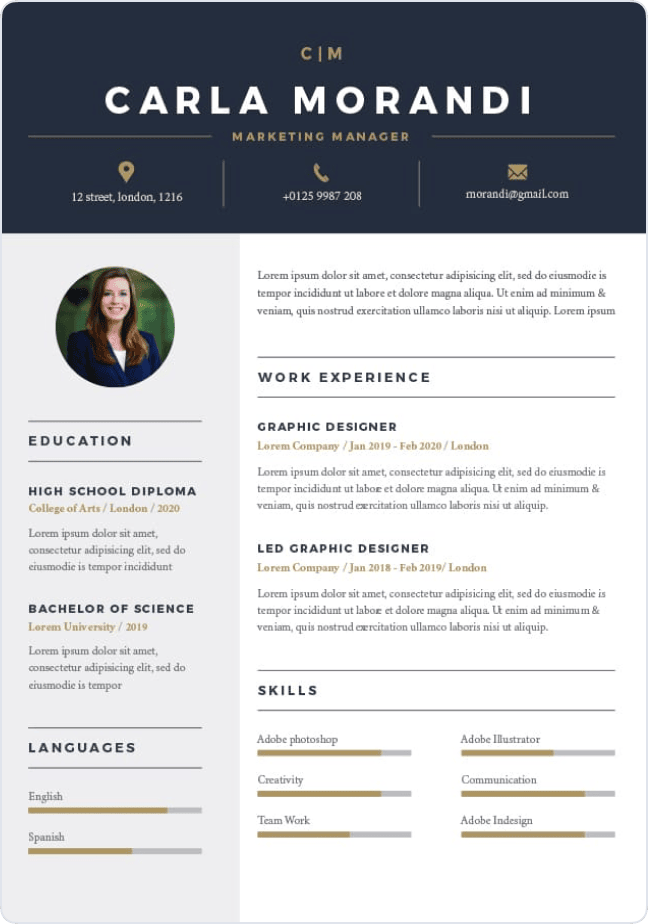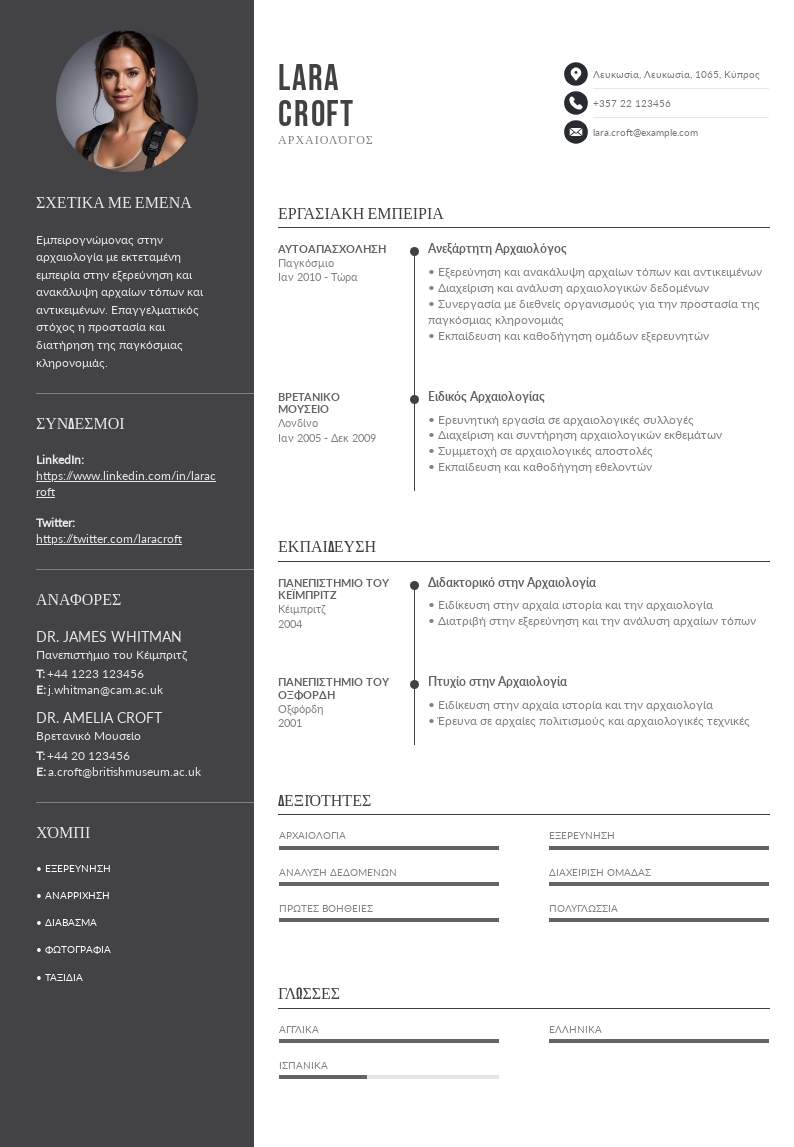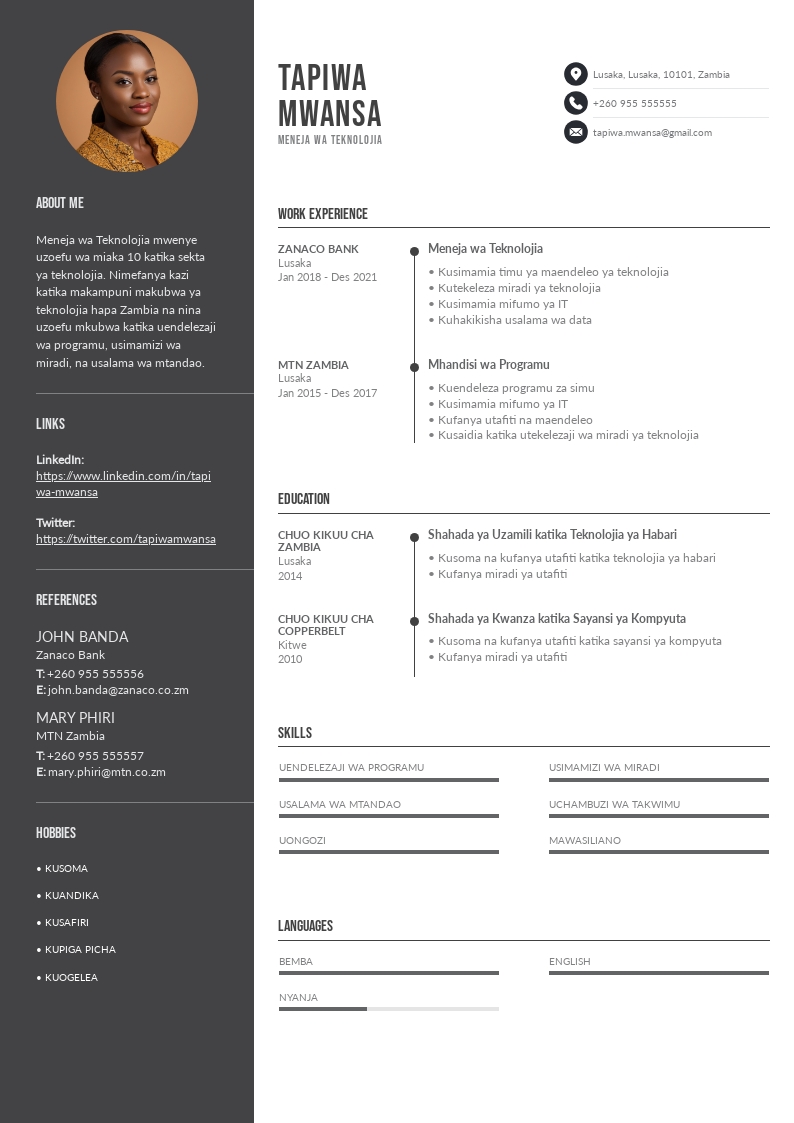Crafting a CV, your professional therapy session, lets employers, like hospitals or private clinics, interpret your cognitive behavioral therapy skills.
Ready to craft a standout resume for a Cognitive Behavioral Therapist role? You're in the right place.
A successful resume should answer some key questions. Here are three questions we often ask ourselves when writing a resume:
- What is the ideal template to use?
- How should I structure my experience and education?
- How can I showcase my skills and grab attention with a compelling summary?
No need to ponder these questions anymore. We've got all the answers for you.
We'll guide you on how to:
- Choose the right template to make your resume shine.
- Structure your experience and education effectively.
- Showcase your skills in a way that's impossible to ignore.
- Write a cool summary that catches attention like a well-placed mirror on a sunny day.
Ready to learn how to craft a successful resume in less than 15 minutes? Let's dive right in. There's nothing "cognitive" about waiting. So prepare yourself to give your resume a "behavioral" makeover. It's time to "therapy" your resume into a job-winning document!

Sample Resume Template for a Cognitive Behavioral Therapist
Below, we will create a sample resume for a Cognitive Behavioral Therapist that you can adjust to suit your personal needs.
Dr. Hannibal Lecter
*1234 Fava Bean Lane, Baltimore, MD 56789*
*Email: h.lecter@psychiatry.com | Phone: (123) 456 - 7890*
Job Title: Cognitive Behavioral Therapist
Professional Experience:
Private Practice Cognitive Behavioral Therapist, Baltimore, MD (June 2015 - Present)
- Provided cognitive behavioral therapy to a diverse clientele, including individuals, couples, and families.
- Assessed, diagnosed, and treated a range of psychiatric disorders.
- Developed tailored treatment plans and regularly evaluated their efficiency.
- Conducted psycho-educational group sessions on stress management, relationship issues, and emotional regulation.
- Maintained comprehensive patient records, including session notes, treatment plans, and progress reports.
Psychiatrist, Baltimore State Hospital for the Criminally Insane (January 2010 - May 2015)
- Provided individual and group therapy to patients with severe mental illnesses.
- Conducted diagnostic assessments and developed treatment plans.
- Supervised and trained junior therapists and interns.
- Collaborated with a multidisciplinary team to ensure the highest quality of care.
- Published several articles in reputable journals on the treatment of severe personality disorders.
Education:
Johns Hopkins University, Baltimore, MD (2005 - 2009)
- Ph.D., Clinical Psychology
- Dissertation: "The Role of Empathy in Treating Antisocial Personality Disorder"
- Graduated with high honors
University of Maryland, College Park, MD (2001 - 2005)
- B.A., Psychology
- Graduated Magna Cum Laude
Skills:
- Patient Assessment
- Treatment Planning
- Group Therapy
- Crisis Intervention
Certifications:
- Licensed Psychologist, State of Maryland
- Certified Cognitive Behavioral Therapist, Association for Behavioral and Cognitive Therapies
Languages:
- English (Native)
- French (Fluent)
- Italian (Fluent)
Hobbies:
- Gourmet Cooking
- Classical Music
- Art History
References:
Dr. Alana Bloom
*Associate Professor, Department of Psychiatry, Johns Hopkins University*
*Email: a.bloom@jhu.edu | Phone: (123) 456 - 7891*
Mastering the Art of Resume Writing for Cognitive Behavioral Therapists: Structure and Formatting Essentials
Ever wondered why a recruiter might take one look at your resume and decide it's nap time? Well, it might just be a case of "CV Fatigue".
Now, how did you decide on your resume template and structure? Did you just pick the first one that popped up on Google?
In a job market as competitive as Cognitive Behavioral Therapy, your resume needs to be as well-structured and attention-grabbing as a captivating therapy session. A striking template and great readability can show your professional edge.
Remember, your CV should reflect the same skills you'd need as a therapist: clarity, organization, and a touch of creativity. A pun here or there wouldn't hurt either, after all, laughter is the best therapy!
Besides the Cognitive Behavioral Therapist Resume Template, we also offer other related templates you may find interesting.
- Medical Billing Specialist CV
- Nurse (LPN/LVN) interview questions
- Anesthesiologist interview questions
- Genetic Counselor interview questions
- Registered Nurse (RN) interview questions
- Orthotist and Prosthetist interview questions
- Patient Services Representative CV entry level
- Medical Billing Specialist CV entry level
- Pharmacy Manager interview questions
Honing the Perfect Resume: Formatting Strategies for Aspiring Cognitive Behavioral Therapists
Have you ever considered the impact of your CV's stylistic setting on your chances of landing your dream job as a Cognitive Behavioral Therapist?
• Fonts: Opt for a professional and readable font such as Arial or Times New Roman. These fonts are not only easy on the eyes but also exhibit a sense of professionalism and seriousness that mirrors the nature of your profession.
• Format: Your CV should follow a reverse chronological format. This not only allows prospective employers to follow your career trajectory easily but also highlights your most recent accomplishments in the field of Cognitive Behavioral Therapy.
• Margins: Keep your margins between 1" and 1.5". This leaves enough white space to make your CV look more organized and neat, and allows the reader to navigate through it effortlessly.
• Bullet Points: Use bullet points to detail your skills, experience, and accomplishments. Bullet points draw attention to your achievements and make your CV easier to skim through, which is a plus for busy recruiters.
• Separators: Use separators such as horizontal lines or distinct headers to differentiate between different sections of your CV. This improves your CV's readability and allows potential employers to find pertinent information quickly.
Now, a dose of advice: All these elements should be blended in a way that makes your CV look cohesive and aesthetically pleasing. Don't forget to check for consistency in your formatting - it's a subtle way to show your attention to detail, a highly valued trait in a Cognitive Behavioral Therapist.
Crafting a Winning Resume for a Cognitive Behavioral Therapist: A Comprehensive Guide
Do you know how to create an outstanding CV that perfectly showcases your skills and experience as a Cognitive Behavioral Therapist? Of course not! That's why I'm here to guide you. Here are the main sections your CV should contain:
- Personal Details: Begin with your name, address, email, and contact number. It's the basics, but you'd be surprised how many people forget this.
- Professional Summary: A concise and catchy summary of your career history, skills, and goals. This should be tailored specifically to cognitive behavioral therapy roles, capturing the attention of the employer immediately.
- Qualifications: List your academic achievements here, starting with your degree in psychology or similar. Highlight relevant qualifications, such as any specialization in cognitive behavioral therapy or mental health.
- CBT Specific Skills: Elaborate on your technical skills and knowledge pertaining to cognitive behavioral therapy. This may include your ability to design and implement therapy programs, manage individual and group therapy sessions, or your expertise in specific CBT techniques.
- Work Experience: List your previous roles in reverse chronological order, highlighting your responsibilities, achievements and the skills you developed. Be sure to mention any roles that involved cognitive behavioral therapy.
- Certifications: If you've undertaken any additional training or earned any certifications relevant to cognitive behavioral therapy, list them here. This could include certifications like the 'Certified Cognitive Behavioral Therapist' credential.
- Professional Affiliations: Showcase your commitment to the field by mentioning your membership in professional bodies like the Association for Behavioral and Cognitive Therapies.
- References: Typically, two references are sufficient. Include their name, title, organization, and contact information. Here's a tip: always ask permission from the person you wish to use as a reference.
Remember, your CV is not just a list of facts about you. It's your chance to tell your professional story in a way that compels the employer to invite you for an interview.
Crafting the Perfect Resume Header for Cognitive Behavioral Therapists

For a Cognitive Behavioral Therapist, the header of their professional documents is crucial, as it should be clearly visible and contain all contact information, including last name, first name, profession, discipline, mailing address, phone number, and email address, ensuring efficient communication and transparency with clients and colleagues.
Dr. Gregory House
Cognitive Behavioral Therapist specializing in mental health treatment
221B Baker Street, Los Angeles, CA 90001, USA
+001 06 9480 9000
greg.house@example.com
Snapping the Perfect Resume Photo for Cognitive Behavioral Therapists
Should a Cognitive Behavioral Therapist's CV include a photo? It's not a straightforward yes or no. The photo isn't a must, but it can give a personal touch, making you seem approachable, and trust is crucial in therapy. However, if you're applying to a firm with strict anti-discrimination policies, skip the photo. If you choose to include one, opt for a professional headshot with a neutral background, display a warm, genuine smile, and dress as you would for a therapy session. A well-chosen photo can help to build an immediate connection, which may just give you an edge over other candidates.
Highlighting Relevant Experiences in Your Cognitive Behavioral Therapist Resume
Crafting a Compelling Experience Section for a Cognitive Behavioral Therapist Resume
In the realm of Cognitive Behavioral Therapy, experience is not just a measure of time spent but a testament to the wide range of cognitive and behavioral disorders handled, the complex client cases navigated and the innovative therapeutic solutions implemented. It is the golden key that unlocks the door to potential employment. However, many applicants blunder in illustrating their experiences, because they fail to dissect the specifics of their roles, thereby offering a shallow and unimpressive account of their abilities. This is a cardinal sin in a field that requires detailed case analysis and personalized therapeutic interventions.
• List your experiences in chronological order. This provides a clear timeline of your professional evolution as a Cognitive Behavioral Therapist, showcasing your ability to adapt to changing therapeutic methodologies and patient needs over time.
• Explicitly mention the contract dates. This demonstrates your commitment and stability in previous roles, a much-needed trait when dealing with patients who require continuity and consistency in their therapy.
• Always specify your job title. This allows potential employers to gauge the level of responsibilities and duties you have held in the past, reflecting your potential for leadership and independent casework within their organization.
• A bulleted list is pivotal in outlining your duties. This offers a crisp, concise snapshot of your capabilities, mirroring the clarity and precision needed in designing cognitive behavioral interventions.
• Craft a comprehensive job description. This indicates your depth of understanding and application of cognitive behavioral therapy principles, techniques, and tools, which is essential in this highly specialized field.
• Finally, sprinkle your description with key words related to Cognitive Behavioral Therapy. This not only shows that you speak the industry's language but also highlights your specialized knowledge and skills, making you a prized catch in the sea of generic applicants.
Remember, your experience section is not just an account of your past—it's your pitch for the future. Make it count.
Position: Lead Cognitive Behavioral Therapist
Employer: Arkham Asylum, Gotham City
Dates: January 2016 - Present
Description:
- Providing CBT for high-profile patient, Mr. Bruce Wayne (Batman).
- Developing and implementing individualized treatment plans.
- Conducting in-depth psychological evaluations and risk assessments.
- Facilitating weekly group therapy sessions for various mental health patients.
- Coordinating with multidisciplinary team for holistic patient care.
Crafting a Compelling Resume for a Cognitive Behavioral Therapist with No Prior Experience

Below are practical and easy-to-use tips for crafting a compelling CV for a Cognitive Behavioral Therapist position, even if you have no direct experience in the field.
- Emphasize relevant education and training:
In the 'Education' section of your CV, highlight any coursework or degrees you have that are relevant to cognitive behavioral therapy (CBT), such as a degree in psychology or a certification in CBT. This can demonstrate your knowledge and commitment to the field. For instance, you might say, "Bachelor's Degree in Psychology with a focus on Cognitive Behavioral Therapy from XYZ University".
- Highlight transferable skills:
Even without direct experience, you can draw attention to skills that would be applicable in a CBT role in the 'Skills' section. This could be communication skills, problem-solving abilities, or empathy. For example, "Exceptional interpersonal and communication skills, honed through varied roles in customer service".
- Include relevant volunteer work or internships:
If you have done any volunteer work or internships that involved counseling or mental health, include these in your 'Experience' section. Even if you weren't specifically a CBT therapist, these experiences can still demonstrate your interest and experience in the field. For example, "Intern at ABC Mental Health Clinic, assisting therapists with patient intake and observing therapy sessions".
The Significance of Education in Crafting a Resume for a Cognitive Behavioral Therapist
Highlighting Your Education in a Resume for Cognitive Behavioral Therapist
The education section in a Cognitive Behavioral Therapist's CV is of paramount importance, as it conveys the therapist's academic qualifications and proficiency in their field. Cognitive Behavioral Therapy is a specialized area of psychology, and as such, requires detailed knowledge and understanding that can only be acquired through rigorous academic training.
To practice as a Cognitive Behavioral Therapist, a minimum of a Master's degree in psychology, counseling, or a related field is typically required. Additionally, many practitioners go on to earn a Doctorate degree. Therefore, the education section provides vital information about a therapist's preparedness and competence. It gives potential employers or clients an overview of the therapist's academic foundation, demonstrating their commitment to their field and their capacity to provide effective therapeutic services.
Prioritizing Educational Qualifications in a Cognitive Behavioral Therapist Resume
In the case of a Cognitive Behavioral Therapist, it is generally advisable for the 'Education' section to appear first in the CV. This is justified by the importance of academic qualifications and specialized training in this profession. These professionals require a deep understanding of psychological principles, diagnostic methods, and therapeutic techniques, which are typically gained through formal education. Thus, recruiters often look for specific degrees or certifications to ensure that the candidate has the necessary knowledge base and skill set. For instance, a Master's degree in Psychology, a Doctorate in Clinical or Counseling Psychology, or specific training in Cognitive Behavioral Therapy might be prerequisites for the role.
However, there might be exceptions to this rule. For example, in the case of a highly experienced Cognitive Behavioral Therapist applying for a senior position, the 'Work Experience' section might be placed first. This is because, in such cases, the recruiter might be more interested in the candidate's practical experience, proven track record, and professional achievements.
Therefore, while the 'Education' section is crucial for a Cognitive Behavioral Therapist's CV, its placement might vary depending on the specific job requirements and the candidate's profile. As in Text 2, the section that best represents the candidate's profile should be placed first.
Education & Certifications
- Doctor of Psychology (PsyD) in Cognitive Behavioral Therapy
University of Oxford, Oxford, UK — 2016-2020
- Master of Science in Psychology
University of Cambridge, Cambridge, UK — 2014-2016
- Bachelor of Science in Psychology
University College London, London, UK — 2011-2014
Certifications:
- Registered with the British Association for Behavioural and Cognitive Psychotherapies (BABCP) — 2020
- Accredited Cognitive Behavioral Therapist — 2020
- Certified in Mental Health First Aid — 2016
Continuing Professional Development (CPD):
- Attended the annual BABCP conference — 2021
- Participated in a workshop on Advanced Techniques in Cognitive Behavioural Therapy — 2020
- Completed an online course on Understanding Anxiety, Depression and CBT through The Open University — 2019
Honing Essential Skills for a Cognitive Behavioral Therapist Resume

Highlighting Your Educational Background for a Cognitive Behavioral Therapist Resume
Skills are a critical part of a resume as they illustrate your abilities, expertise, and what you can bring to the table. Recruiters look at the skills section of a resume to determine if the candidate's abilities align with the job requirements. It's not just about having the necessary skills, but also about demonstrating how you've used these skills in past roles to achieve results.
In the case of a Cognitive Behavioral Therapist position, showcasing relevant skills on your resume is particularly crucial. Cognitive Behavioral Therapists need a unique blend of skills, including empathy, communication, problem-solving, and knowledge of various therapeutic techniques. Beyond these, however, you also need to highlight your experience and proficiency in cognitive-behavioral therapy (CBT), as this is the primary treatment modality you'll be working with. Demonstrating these skills can help the recruiter see your potential effectiveness in helping clients manage their issues.
Key Skills to Highlight on Your Resume as a Cognitive Behavioral Therapist
A Cognitive Behavioral Therapist's resume should highlight a range of technical skills and personal qualities that are highly sought after by recruiters in this field.
Technical Skills:
- Cognitive Behavioral Therapy
- Case Management
- Patient Assessment
- Mental Health Counseling
- Treatment Planning
- Crisis Intervention
Personal Qualities:
- Empathy and Understanding
- Excellent Communication
- Patience and Positivity
- Problem-Solving Skills
- Confidentiality Maintenance
- Active Listening Skills
Honing the Summary Section of Your Cognitive Behavioral Therapist Resume
The summary in a CV for a Cognitive Behavioral Therapist (CBT) is of paramount importance because it provides prospective employers with a brief yet comprehensive overview of your qualifications, skills, and experience in the field. It's the first section that recruiters will read, serving as a snapshot of your professional profile. An effective summary can quickly highlight your expertise in using cognitive behavioral therapy techniques, your understanding of mental health disorders, and your ability to develop and implement effective treatment plans. It may also reflect your interpersonal skills, capacity for empathy, and commitment to patient care. The summary can thus significantly impact the impression you make, either encouraging the reader to consider your application further or leading them to dismiss it. Therefore, a well-crafted summary is crucial for capturing attention, setting the tone for the rest of your CV, and ultimately increasing your chances of securing a job interview.
Passionate and dedicated Cognitive Behavioral Therapist with over 5 years of experience in providing effective patient-centered treatment. Known for developing innovative treatment plans and delivering high-quality care. Committed to improving patients' mental health and well-being. Excited to bring expertise in CBT to a dynamic and supportive team.
Honing Your Resume: Extra Sections to Include for Cognitive Behavioral Therapists
Additional sections, such as "Languages" and "Certificates," could be essential inclusions in a Cognitive Behavioral Therapist CV. These added categories give a more comprehensive and specific view of your qualifications and skills. They provide the potential employer with a clearer image of your professional capabilities beyond the standard sections of the CV.
Languages
As a Cognitive Behavioral Therapist, language skills are of significant importance. The nature of the job involves direct communication with clients who may have diverse linguistic backgrounds. Proficiency in more than one language could be a substantial advantage, as it broadens the range of clients you can effectively work with. It could also be a defining factor if the job involves working with a specific community or population. Therefore, clearly stating your language proficiencies, including your native language and any additional languages you are fluent in, can strengthen your CV.
Certificates
The "Certificates" section is a crucial part of a Cognitive Behavioral Therapist CV. This field allows you to showcase any additional qualifications or specialized training you have acquired that are relevant to the job. Having additional certificates in areas like child psychology, trauma-focused therapy, or anxiety disorders, for example, could set you apart from other applicants. It indicates your commitment to continuous learning and professional development, which is highly valued in the field of therapy. Remember to include the name of the certificate, the granting institution, and the date of achievement.
Honing Your Resume for a Successful Career as a Cognitive Behavioral Therapist
In order to create a more impactful CV for a Cognitive Behavioral Therapist position, you may want to consider the following tips:
- Highlight your academic achievements in the field of psychology, particularly any specializations you have in cognitive behavioral therapy.
- Include any certifications or professional training you have received in cognitive behavioral therapy.
- Detail your experience in conducting cognitive behavioral therapy sessions, including the types of cases you have handled and the techniques you have used.
- Showcase your ability to establish rapport with patients and maintain strong therapeutic relationships.
- List any research or publications you have contributed to in the field of cognitive behavioral therapy.
- Be sure to mention any notable achievements or recognitions you have received in your career as a cognitive behavioral therapist.
- Include specific examples of how you have made a difference in your clients' lives through cognitive behavioral therapy.
- Highlight your skills in using technology, as many cognitive behavioral therapy sessions are now being conducted online.
Honing Your Resume: Key Elements for Aspiring Cognitive Behavioral Therapists

In writing your Cognitive Behavioral Therapist CV, remember the following key points:
Ensure your CV is structured and well-presented, as it is representative of your professional persona.
Use a consistent, easy-to-read font throughout your CV to maintain readability.
Clearly present your professional experience, giving specific details about your experience in cognitive behavioral therapy.
Include your achievements in the field, such as successful case studies or recognitions received.
Highlight your personal skills and specialized skills relevant to cognitive behavioral therapy.
Proofread your CV thoroughly to avoid any errors in grammar or content.
Avoid including irrelevant information that doesn't contribute to your candidacy for the role.
Lastly, don't ignore gaps in your career timeline; instead, fill them with other significant experiences like volunteering, research work, or additional studies.
Crafting a Captivating Cover Letter for a Cognitive Behavioral Therapist Position
Including a cover letter with your resume when applying for a Cognitive Behavioral Therapist position is vital for several reasons. Firstly, it enables you to express your passion and enthusiasm for the role, which a resume alone might not capture. It also provides an opportunity to detail your experience and skills in cognitive behavioral therapy and how they align with the job requirements.
In your cover letter, remember to address the specific needs of the cognitive behavioral therapist position. If you're finding it challenging to write this document, we have sample cover letters tailored for therapist roles that you can use as references. This will ensure your cover letter is comprehensive and compelling to potential employers.
Frequently Asked Questions About Crafting a Resume for a Cognitive Behavioral Therapist Role
As a Cognitive Behavioral Therapist, it is crucial to highlight your interpersonal skills, communication skills, and problem-solving abilities. In addition, it's essential to mention your experience with cognitive behavioral therapy techniques, treatment planning, and your ability to work with diverse patient populations. Showcasing any specialized training or certifications in areas like trauma, addiction, or child behavioral disorders can also give your CV an edge.
The ideal length of a Cognitive Behavioral Therapist's CV largely depends on the breadth of your experience and the country you're applying in. Generally, if you're applying for positions in the US, it's best to limit your CV to one or two pages. However, if you're applying internationally or for academic positions, a longer CV detailing all of your experiences, certifications, and publications may be acceptable.
Transitioning into a career as a Cognitive Behavioral Therapist requires specific educational and licensure requirements. First, you need to earn a bachelor's degree, preferably in psychology or a related field. Then, you need to complete a master's degree in counseling or clinical psychology, and specific coursework in cognitive behavioral therapy is often recommended. Finally, you must earn a state license to practice, which typically involves meeting supervised clinical experience requirements and passing a state-recognized exam.































